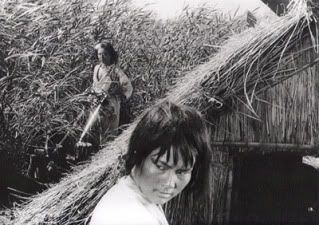The Dark Knight is a substantial improvement over
Batman Begins, which got bogged down in tedious minutiae regarding martial arts training and assorted origin story geekery. As someone who is not especially a fan of the character, I really didn't give a rat's ass. This film, on the other hand, is ... well ... simply a lot more fun.
Is fun the right word? Yes. Much has been made of how dark the film is, how frightening its lead villain. Since the film's release, mainstream audiences have declared with their pocketbooks that they can take it. Of course they can. Setting aside for a moment the absurd notion that the film ranks among the greatest of all time (no ... it does not), the main reason, in my estimation, that
The Dark Knight has achieved such overwhelming financial success is because The Joker is a dead perfect fit for our times. And his execution (I will give credit not only to Ledger, but to Nolan and company as well) is also the element that will make this film memorable.
Popping up when unexpected, carrying with him anarchic disillusionment, ready to explode into violence on a whim, The Joker perfectly encapsulates our feelings of helplessness in the face of a world going down the tubes. We look to the people who hold the world in balance (I'm not even talking about terrorists -- elected officials!) and they seem much like madmen. How many times have we thought that new news events would be absurdly comic if they weren't also of dire importance? Heath Ledger understands this connection and plays it to the hilt, never allowing the cartoonish aspects of his character to drain away his capability for danger. Even when he is away for long stretches of time, his presence looms over the film and we are held in attention anticipating his return. Let it be said: this is not a case of a star's tragic death leading to undeserved adulation. This is a supreme performance. Pure and simple.
Unfortunately, the same cannot be said for Christian Bale's performance as the title character. His sullen, personality-free take on Bruce Wayne is tolerable, I suppose. However, his bizarre decision to play Batman as if he were squaring off against The Undertaker in Wrestlemania XII is a head scratcher. I've always thought that Bale was one of the most overpraised actors alive. But it's hard to imagine even his supporters defending his laughable vocal exertions which threaten to derail scenes that would otherwise be filled with tension. Aaron Eckhart as Harvey Dent runs into a similar problem, though not as extreme. When he is interacting casually, he is a perfectly capable actor. However, when later events force him into heightened levels of emotion, he just doesn't seem to have the conviction to match the moment.
As a director, Nolan is efficient, keeping the pace of this long film moving at a satisfying clip; however, there is very little art to his approach. He lacks the flair and creativity that Sam Raimi brings to the Spiderman films. I also thought that the editing felt rushed in places, as if the film was jumping to the next thought before it had finished the previous sentence. This did not feel like any sort of calculated tactic to disrupt the film's pacing. It just felt kind of sloppy.
My final criticism of the film is fairly significant, I think, and prevents me from holding the piece in higher esteem. It's simply this: the character of Batman with his armored car and his silly rubber suit and his Rex Kwan Do gets swallowed up by the enormity of the menace he faces. Perhaps he is a Super Cop, but the Gotham city police force still seems to be doing a lion's share of the work. From time to time, he is able to turn the tide with a timely gadget. But I just don't get the feeling in this battle of good and evil that the town really
needs him. I don't understand his need for secrecy. I don't understand why he keeps his technology to himself. I don't understand why his vigilante status helps him to be more effective at fighting crime.
Criticisms aside, this was pretty much engaging from start to finish, with only a couple of dead spots. Thanks to Ledger and the Joker character, the film actually had some legitimate laughs this time as well, not just that dopey 'comic' banter between Bruce Wayne and his butler. The film has numerous flaws. But when it's good ... it's awfully damn good.
[***]





